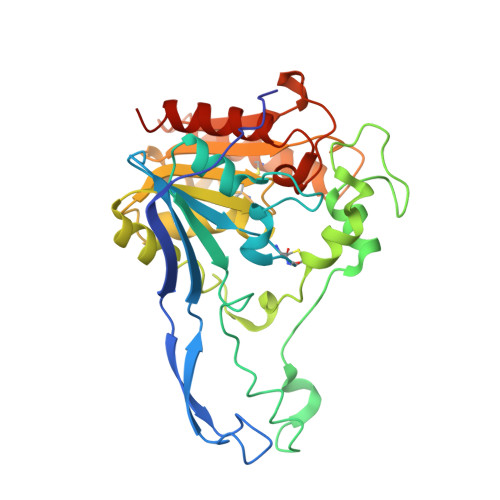The Atomic Resolution Structure of a Novel Bacterial Esterase
Bourne, P.C., Isupov, M.N., Littlechild, J.A.(2000) Structure 8: 143
- PubMed: 10673440
- DOI: https://doi.org/10.1016/s0969-2126(00)00090-3
- Primary Citation of Related Structures:
1QLW, 2WKW - PubMed Abstract:
A novel bacterial esterase that cleaves esters on halogenated cyclic compounds has been isolated from an Alcaligenes species. This esterase 713 is encoded by a 1062 base pair gene. The presence of a leader sequence of 27 amino acids suggests that this enzyme is exported from the cytosol. Esterase 713 has been over-expressed in Agrobacterium without this leader sequence. Its amino acid sequence shows no significant homology to any known protein sequence. The crystal structure of esterase 713 has been determined by multiple isomorphous replacement and refined to 1. 1 A resolution. The subunits of this dimeric enzyme comprise a single domain with an alpha/beta hydrolase fold. The catalytic triad has been identified as Ser206-His298-Glu230. The acidic residue of the catalytic triad (Glu230) is located on the beta6 strand of the alpha/beta hydrolase fold, whereas most other alpha/beta hydrolase enzymes have the acidic residue located on the beta7 strand. The oxyanion hole is formed by the mainchain nitrogens of Cys71 and Gln207 as identified by the binding of a substrate analogue, (S)-7-iodo-2,3,4,5-tetrahydro-4-methyl-3-oxo-1H-1, 4-benzodiazepine-2-acetic acid. Cys71 forms a disulphide bond with the neighbouring Cys72. Despite negligible sequence homology, esterase 713 has structural similarities to a number of other esterases and lipases. Residues of the oxyanion hole were confirmed by structural comparison with Rhizomucor miehei lipase. It is proposed that completion of a functional active site requires the formation of the disulphide bond between adjacent residues Cys71 and Cys72 on export of the esterase into the oxidising environment of the periplasmic space.
Organizational Affiliation:
Schools of Chemistry and Biological Sciences, University of Exeter, Exeter, EX4 4QD, UK.















